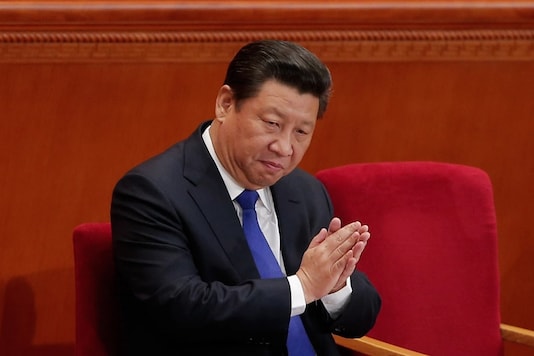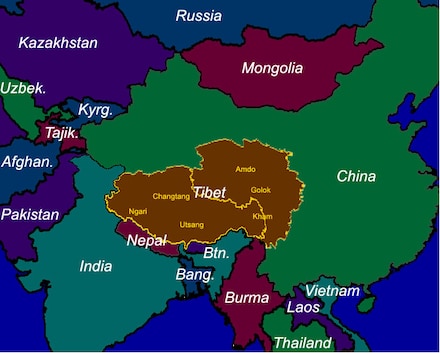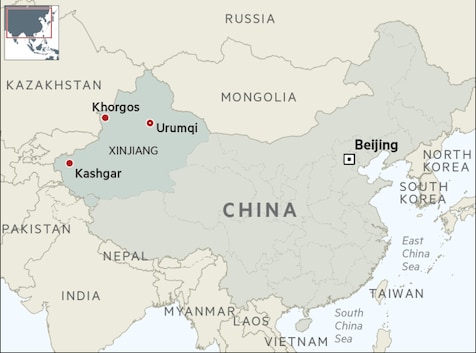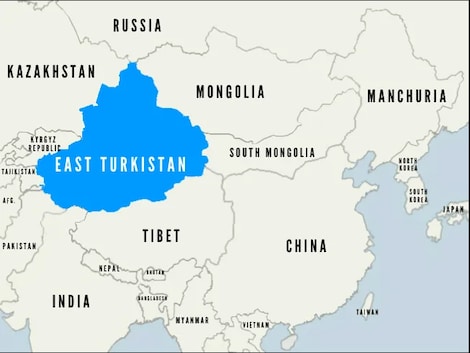
Thirty one per cent of China is forcefully occupied. That is when we go with the official Chinese record. China forcefully occupied Xinjiang in 1949 and Tibet in 1950. As per the official Chinese record, the Xinjiang Uyghur Autonomous Region has an area of 1.66 million square kilometers, that is 17.68% of total land area of China, i.e., 93,88,210 square kilometers, as per the World Bank Databank.
The Tibet Autonomous Region (TAR) has an area of 1.22 million square kilometre, i.e., 13% of the total land area of China — that makes 31% of the total land area of China. And 44.31% if we take into account the claims made by Tibetan Government in Exile in India or Central Tibetan Administration.
The Central Tibetan Administration claims historical Greater Tibet has a land area of 2.5 million square kilometers and the bulk of historical Tibet lies outside the Tibet Autonomous Region. China had already merged more than half of the Greater Tibet in other Chinese provinces before it announced the formation of TAR in 1965.
China also occupies two pieces of Indian territories. It includes Aksai Chin, a 38,000 square kilometre border area in Ladakh that China occupied in 1962 India-China war while Pakistan ceded to China 5,180 square kilometre of occupied Indian territory in 1963 under Sino-Pakistan boundary agreement.
Though 43,180 square kilometre of occupied Indian territories only makes for a slight increase, from 44.31% to 44.77%, it very well tells about the expansionist designs of the Chinese government. China is currently involved in territorial disputes with over 20 countries including India, Nepal, Bhutan and Japan.
MAP OF TIBET, XINJIANG AND INDIAN TERRORITORIES SUPERIMPOSED ON CHINA



CALLS FOR INDEPENDENCE
The native population of Xinjiang is Uyghur Muslims while Tibetans are followers of Buddhism. They have always been fiercely patriotic, throughout the history, struggling to make their homeland free from the Chinese and Mongol dynasties earlier and the People’s Republic of China now.
Uyghur Muslims’ government-in-exile is US based, the East Turkistan Government in Exile. They call Xinjiang East Turkistan based on their Turkic origin. Uyghur Muslims had brief periods of independence twice during the China’s civil war with an independent Islamic Republic of East Turkistan. Uyghur activists celebrate independency day on November 12.
Tibetan government-in-exile is located in India. It is headed by a democratically elected President in Exile. Earlier, the Dalai Lama, a globally respected figure, Nobel Laureate and the most important Tibetan monk, was used to be the supreme spiritual and political authority of Tibet but he decided to hand over the political structure to a democratically elected system in 2011.
Tibetans celebrate their Independence Day on February 13 and Tibet Uprising Day on March 10. Tibet was declared an independent nation on February 13, 1913.
On March 10, 1959, Tibetans revolted against Chinese suppression. Tibetans suspected China planned to kidnap the Dalai Lama and start a new scale of violence and suppression. 300,000 Tibetans surrounded the Dalai Lama’s palace and he was evacuated to India. Violence broke out in Tibetan capital Lhasa and in other parts of Greater Tibet against the Chinese rule. In response, China destroyed the Dalai Lama’s palace and thousands of Tibetan monasteries and killed tens of thousands of people to crush the uprising according to different human rights reports.
How China occupied these two independent territories with different culture and religions?
XINJIANG
Historically, the region was inhabited by tribal alliances and small kingdom of Turkic origin people and was ruled by several dynasties. Around 60 BCE, it came under control of the Han Dynasty of China. Local Uyghur leaders against retook the area in 3rd Century. Tang Dynasty of China tried to increase its influence the region but Arabs got the better head start. Islam arrived in the region in 8thcentury and soon became the main religion.
Tribes in the region always opposed a foreign rule, be it Mongol king Genghis Khan’s victory in 13th century or China’s Qing Dynasty assertion later on that created the Xinjiang Province in 1884.
With China’s prolonged civil war in the first half of the 20th century, Uyghur Muslims declared impendence twice. First was during 1933-34 when they declared the Islamic Republic of East Turkistan. The Uyghur Republic fell soon after Soviet help to the Chinese government. Second independent Uyghur state existed from 1944 to 1949.
TIBET
China claims to rule Tibet historically but Tibet has had an independent history since 7th century. China and Tibet, in fact, signed a peace treaty in 822 A.D. But 13th century onwards, the peace-loving Buddhists in Tibet were ruled by foreigners, first by Mongols, then by Chinese.
Mongols conquered Tibet in 1244. Next centuries saw prolonged wars between Chinese and Mongol dynasties. In 1720, Chinese emperor Kangxi defeated Mongols finally after over two centuries of war. British East India set its foot in Tibet in 1774. The next centuries saw Britain and China trying to control the Tibetan territory.
In 1913, Tibet declared independence and remain independent till 1949. China, with its internal problems like military revolt, end of royal rule and Japanese invasion was not in a position to assert its control. But the communist rule in China saw otherwise. In 1949, Mao Zedong threatened Tibet , calling it a Chinese territory and invaded it in 1950. In 1951, China established civil and military headquarter at Tibetan capital Lhasa.
HISTORICAL SOVERIGNITY CLAIMS?
Different dynasties ruling China, from time to time, tried to colonize independent Xinjiang and Tibet territories in their expansionist mode. In fact ancient, medieval and recent history is replete is such examples from across the world, like India being colonized by Britain and China by Japan in recent past.
But after two world wars in 20th century, the world history saw an overturn, with an end of the colonial superpowers and a beginning of the independent free nations from the grip of colonial suppression, like India got its independent from the British rule and China seized it from the Japanese expansionism in the Chinese territory.
But while that may be the global norm as of now, some of the countries are still living in that colonial past and China is its prime example. The Chinese Communist Party that rules China since 1949 occupied Xinjiang and Tibet seven decades ago and is still having expansionist designs to occupy independent nations like Nepal and Bhutan and Indian territories Ladakh, Arunachal Pradesh and Sikkim, something that People’s Republic of China founder Mao Zedong referred to as the five fingers of Tibet.
When Iraq invaded and occupied Kuwait in August 1990, we saw a huge military operation sanctioned by the United Nations and led by the US, the ‘Operation Desert Storm’, too free Kuwait. Kuwait was liberated in February 1991. But the major powers of the world and the United Nations so far have avoided taking any stand when it comes to the Chinese occupation and atrocities in Xinjiang and Tibet.
To suppress the struggles of ethnic minorities China has cultivated a policy of mass genocide in Xinjiang and Tibet, both at demographical and cultural levels. The country has forced measures like coercive birth prevention, has banned religious practices, has mass interned the ethnic minority population and at the same time, has mass-migrated the Han Chinese population from other parts of mainland China to Xinjiang and Tibet.
No comments:
Post a Comment